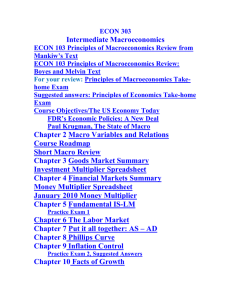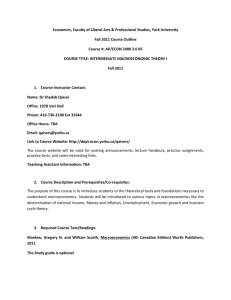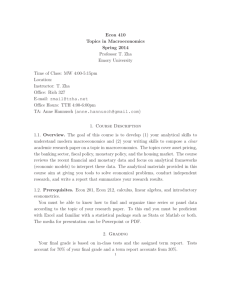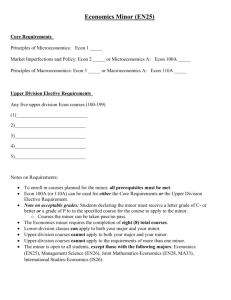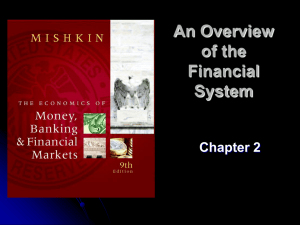Macroeconomics of Financial Markets ECON 406a, Fall 2010 September 6, 2010 Guillermo Ordo˜
advertisement
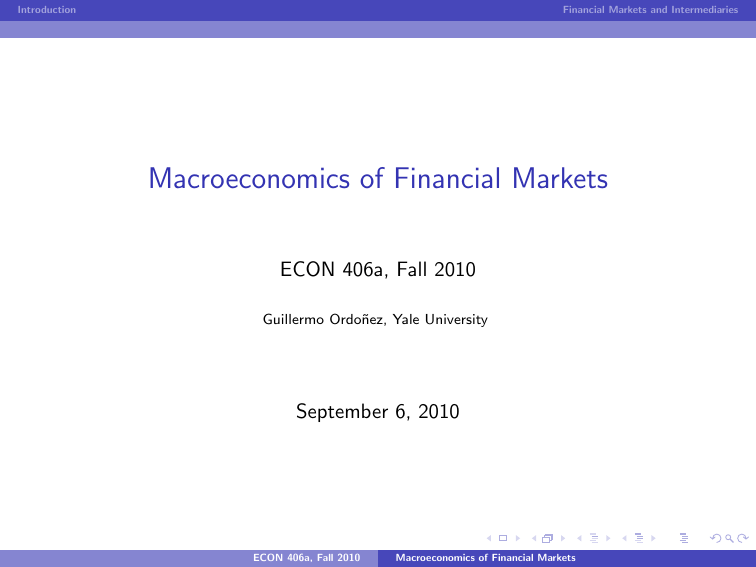
Introduction Financial Markets and Intermediaries Macroeconomics of Financial Markets ECON 406a, Fall 2010 Guillermo Ordoñez, Yale University September 6, 2010 ECON 406a, Fall 2010 Macroeconomics of Financial Markets Introduction Financial Markets and Intermediaries Course Information Instructor: Guillermo Ordonez (guillermo.ordonez@yale.edu) Teaching Fellow: Adam Osman (adam.osman@yale.edu) Lectures: Mondays and Wednesdays, 13:00 to 14:15. WLH 114 Discussion: Mondays, 17:00 to 17:50. ??? Office Hours: Wednesdays 16:00 to 18:00. 28 Hillhouse Av. Rm 208. Also by appointment. ECON 406a, Fall 2010 Macroeconomics of Financial Markets Introduction Financial Markets and Intermediaries Objectives Are financial markets important for development? Are financial markets important for economic fluctuations? What policies can be implemented to enhance the positive effects and to reduce the negative effects of financial markets? ECON 406a, Fall 2010 Macroeconomics of Financial Markets Introduction Financial Markets and Intermediaries Objectives Are financial markets important for development? Are financial markets important for economic fluctuations? What policies can be implemented to enhance the positive effects and to reduce the negative effects of financial markets? To answer these questions we’ll work on four steps. ECON 406a, Fall 2010 Macroeconomics of Financial Markets Introduction Financial Markets and Intermediaries Road Map Weeks 1-3: Microeconomic foundations of financial markets. Weeks 4-6: Macroeconomic implications of financial markets. Weeks 7-9: Empirical evidence. Weeks 10-13: Country experiences. ECON 406a, Fall 2010 Macroeconomics of Financial Markets Introduction Financial Markets and Intermediaries Zooming the Road Map Weeks 1 - 3 Why financial markets are so different than other markets? TIME!!!. In financial markets trade is not for something now, but for the promise of something in the future. Their links touch every element of the economy. ECON 406a, Fall 2010 Macroeconomics of Financial Markets Introduction Financial Markets and Intermediaries Zooming the Road Map Weeks 1 - 3 Why financial markets are so different than other markets? TIME!!!. In financial markets trade is not for something now, but for the promise of something in the future. Their links touch every element of the economy. Why financial intermediaries exist? Asymmetric Information between borrowers and lenders. Adverse selection and moral hazard. Need for information and monitoring. Need for liquidity and consumption smoothing. ECON 406a, Fall 2010 Macroeconomics of Financial Markets Introduction Financial Markets and Intermediaries Zooming the Road Map Week 4 How do financial markets affect growth and development? Better quality and quantity of information. Lower cost of financing for risky and large investments. Better allocation of resources. Consumption smoothing. Risk diversification. ECON 406a, Fall 2010 Macroeconomics of Financial Markets Introduction Financial Markets and Intermediaries Zooming the Road Map Weeks 5 - 6 How macroeconomic models have evolved to account for financial markets? Not much role to financial markets: Classical, Keynes, Debt-Deflation Theories, Keynesian, Monetarism, Neoclassical. Some role to financial markets: New theories generated in 80s and 90s. ECON 406a, Fall 2010 Macroeconomics of Financial Markets Introduction Financial Markets and Intermediaries Zooming the Road Map Weeks 5 - 6 How macroeconomic models have evolved to account for financial markets? Not much role to financial markets: Classical, Keynes, Debt-Deflation Theories, Keynesian, Monetarism, Neoclassical. Some role to financial markets: New theories generated in 80s and 90s. Do financial markets create economic crises? Few studies about this,.... but nowadays it is critical. Endogenous generation of bubbles and panics. Do financial markets magnify economic crises? Financial markets magnify and spread negative shocks in real activity. Balance sheet channel.....but there may be other channels. ECON 406a, Fall 2010 Macroeconomics of Financial Markets Introduction Financial Markets and Intermediaries Zooming the Road Map Weeks 7 - 9. Evidence on the effects of financial development on growth. Evidence on the effects of financial liberalization on growth. Evidence of the effects of financial markets on economic fluctuations. Bubbles, panics and crashes. ECON 406a, Fall 2010 Macroeconomics of Financial Markets Introduction Financial Markets and Intermediaries Zooming the Road Map Weeks 10 - 13. Financial crises and policy responses. 19th century crises. Great Depression. Chile and Mexico. Japan. Scandinavian countries. Recent crisis. ECON 406a, Fall 2010 Macroeconomics of Financial Markets Introduction Financial Markets and Intermediaries Routine Weeks 1-9, Every weekend I’ll post notes (slides) for the following week. Try to take a look at them before classes! I’ll start each topic with the main questions and a summary of answers. Discussion in class will be very important! Weeks 10-13, I’ll start each class with the main questions, data and methodology. Short presentations by students. Discussions. ECON 406a, Fall 2010 Macroeconomics of Financial Markets Introduction Financial Markets and Intermediaries Grading 15 % - Problem Set 1 (after week 3) 15 % - Problem Set 2 (after week 6) 15 % - Take home exam (after week 9) 15 % - Presentation (weeks 10-13) 40 % - Term paper (due December 10th, 2010). ECON 406a, Fall 2010 Macroeconomics of Financial Markets Introduction Financial Markets and Intermediaries Financial Markets Trade of financial instruments by individuals and institutions. ECON 406a, Fall 2010 Macroeconomics of Financial Markets Introduction Financial Markets and Intermediaries Financial Markets Trade of financial instruments by individuals and institutions. Who trade? Debtors are individuals or institutions who want to spend more than their current income. Creditors are individuals or institutions who want to spend less than their current income. Financial markets provide a way for the first group to borrow from the second group. ECON 406a, Fall 2010 Macroeconomics of Financial Markets Introduction Financial Markets and Intermediaries Financial Markets Trade of financial instruments by individuals and institutions. What do they trade? Cash instruments: Value determined by the market. Generated by debtors’ needs to purchase an asset today (investment) and creditors’ needs to accumulate resources for the future (savings). Types Cash: Borrower and lender agree to a transfer (Loans and Deposits). Securities: Readily transferrable instruments (Stocks, Bonds, Commercial Paper, T-Bills). ECON 406a, Fall 2010 Macroeconomics of Financial Markets Introduction Financial Markets and Intermediaries Financial Markets Trade of financial instruments by individuals and institutions. What do they trade? Derivatives. Value determined by the underlying assets. Generated by institutional needs to insure against future bad shocks. Types OTC (over the counter): Contracts traded directly between two parties (Stock Options, Bond Futures, Interest Rate Futures). Exchange-traded: Standardized contracts traded via specialized future exchanges (Stock Options, Forward Rates, Credit Swaps, Exotic Instruments). ECON 406a, Fall 2010 Macroeconomics of Financial Markets Introduction Financial Markets and Intermediaries Financial Intermediation MOST of this trade is done by financial intermediaries. Financial intermediaries channel funds from creditors to debtors. Types Commercial Banks. (depository institutions) Institutions whose current operations consist in granting loans and receiving deposits from the public. Mutual funds. Pension funds. Insurance companies. Finance companies. Asset back securities issuers. ECON 406a, Fall 2010 Macroeconomics of Financial Markets Introduction Financial Markets and Intermediaries Financial Intermediation Financial intermediaries channel funds from creditors to debtors. Types Commercial Banks. (depository institutions) Mutual funds. Pools money from many investors and a manager invests, typically in securities. After deducting managers fees, the gains from investments are distributed to the investors, at least annually. Hedge funds invest in riskier alternatives (short selling, derivatives,..) Pension funds. Insurance companies. Finance companies. Asset back securities issuers. ECON 406a, Fall 2010 Macroeconomics of Financial Markets Introduction Financial Markets and Intermediaries Financial Intermediation Financial intermediaries channel funds from creditors to debtors. Types Commercial Banks. (depository institutions) Mutual funds. Pension funds. Common asset pool meant to generate stable growth, and provide pensions for retirees. Managed by large intermediaries. Largest investors in most countries. Insurance companies. Finance companies. Asset back securities issuers. ECON 406a, Fall 2010 Macroeconomics of Financial Markets Introduction Financial Markets and Intermediaries Financial Intermediation Financial intermediaries channel funds from creditors to debtors. Types Commercial Banks. (depository institutions) Mutual funds. Pension funds. Insurance companies. Provide insurance policy to individuals and companies to avoid possible bad shocks. Finance companies. Asset back securities issuers. ECON 406a, Fall 2010 Macroeconomics of Financial Markets Introduction Financial Markets and Intermediaries Financial Intermediation Financial intermediaries channel funds from creditors to debtors. Types Commercial Banks. (depository institutions) Mutual funds. Pension funds. Insurance companies. Finance companies. Make loans to individuals or businesses, obtains its financing from banks and other money market sources, not deposits. Asset back securities issuers. ECON 406a, Fall 2010 Macroeconomics of Financial Markets Introduction Financial Markets and Intermediaries Financial Intermediation Financial intermediaries channel funds from creditors to debtors. Types Commercial Banks. (depository institutions) Mutual funds. Pension funds. Insurance companies. Finance companies. Asset back securities issuers. An asset-backed security is a security whose value and income payments are ”backed” by a specified pool of underlying assets. Special purpose vehicles are remote companies (with a sponsor) that create and sells these ABS (like CDOs, CLOs, etc). ECON 406a, Fall 2010 Macroeconomics of Financial Markets Introduction Financial Markets and Intermediaries Financial Intermediaries are Key Net Lending in Billions of Dollars (Fed Flow of Funds) ECON 406a, Fall 2010 Macroeconomics of Financial Markets Introduction Financial Markets and Intermediaries Commercial Banks are the Most Important ECON 406a, Fall 2010 Macroeconomics of Financial Markets Introduction Financial Markets and Intermediaries Mutual Funds Have Increased in Importance ECON 406a, Fall 2010 Macroeconomics of Financial Markets Introduction Financial Markets and Intermediaries Pension Funds and Insurance Companies are Stable ECON 406a, Fall 2010 Macroeconomics of Financial Markets Introduction Financial Markets and Intermediaries Finance Companies also Collapsed ECON 406a, Fall 2010 Macroeconomics of Financial Markets Introduction Financial Markets and Intermediaries ABS Issues Collapsed Before the Rest ECON 406a, Fall 2010 Macroeconomics of Financial Markets Introduction Financial Markets and Intermediaries Intervention of the Federal Reserve Bank ECON 406a, Fall 2010 Macroeconomics of Financial Markets Introduction Financial Markets and Intermediaries Banks Are the Most Important Source of Finance A lot of external finance comes from banks (25%). What are banks unique characteristics? Banks borrow from a group of agents that save (households) and lend to another group of agents that invest (firms). Banks’ borrowing and lending groups are large. Diversification. Banks borrow short-term and lend long-term. Maturity mismatch. ECON 406a, Fall 2010 Macroeconomics of Financial Markets Introduction Financial Markets and Intermediaries Banks’ Balance Sheet Total Assets = Total Liabilities Composition is from the Fed (July 2010) Assets. Cash. (10%) Securities. (20%) Loans. (57%) Other Assets. (13%) Liabilities. Deposits. (75%) Borrowings. (20%) Equity (Bank capital or Net Worth). (5%) ECON 406a, Fall 2010 Macroeconomics of Financial Markets Introduction Financial Markets and Intermediaries Banks’ Important Functions What are banks’ main functions? Offering liquidity and payment services. Transforming assets. Managing risks. Processing information and monitoring borrowers. ECON 406a, Fall 2010 Macroeconomics of Financial Markets Introduction Financial Markets and Intermediaries Banks’ Important Functions What are banks’ main functions? Offering liquidity and payment services. Money changing and safekeeping of deposits. Payment services and clearinghouses. Transforming assets. Managing risks. Processing information and monitoring borrowers. ECON 406a, Fall 2010 Macroeconomics of Financial Markets Introduction Financial Markets and Intermediaries Banks’ Important Functions What are banks’ main functions? Offering liquidity and payment services. Transforming assets. Convenience of denomination. Quality transformation. Maturity transformation. Managing risks. Processing information and monitoring borrowers. ECON 406a, Fall 2010 Macroeconomics of Financial Markets Introduction Financial Markets and Intermediaries Banks’ Important Functions What are banks’ main functions? Offering liquidity and payment services. Transforming assets. Managing risks. Credit risks. Market risks. Off-balance sheet operations. Processing information and monitoring borrowers. ECON 406a, Fall 2010 Macroeconomics of Financial Markets Introduction Financial Markets and Intermediaries Banks’ Important Functions What are banks’ main functions? Offering liquidity and payment services. Transforming assets. Managing risks. Processing information and monitoring borrowers. Ex-ante information about the prospects of investment. Ex-post information about the results of investment. ECON 406a, Fall 2010 Macroeconomics of Financial Markets Introduction Financial Markets and Intermediaries But Banks are Also Fragile Between 1980-95, 35 countries experienced banking crises (banks stopped functioning). Banking crises are typically accompanied by economic crises. It is not clear which one leads and which one follows. ECON 406a, Fall 2010 Macroeconomics of Financial Markets Introduction Financial Markets and Intermediaries Worst Banking Crises since 1980 Country Crises Dates Argentina (+1) 1980-1982 Indonesia (+1) 1997-1998 China 1990s Jamaica (+1) 1994 Chile (+1) 1981-1983 Thailand (+1) 1997 Macedonia 1993-1994 Israel 1977-1983 Turkey (+1) 2000 Uruguay 1981-1984 Korea 1998 Cote d’Ivoire 1988-1991 Japan 1990s Uruguay 1981-1984 Malaysia (+1) 1997-1998 Source: Caprio and Klingbiel (2003) ECON 406a, Fall 2010 Estimated Cost of Bailout (as percentage of GDP) 55 55 47 44 42 35 32 30 30 29 28 25 24 24 20 Macroeconomics of Financial Markets
